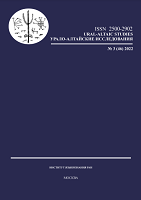Phonetic and lexical innovations in Ob-Ugric dialects in the 18th—21st centuries: new archival and field data
Phonetic and lexical innovations in Ob-Ugric dialects in the 18th—21st centuries: new archival and field data
Author(s): J. V. Normanskaya, Idaliya V. FedotovaSubject(s): Phonetics / Phonology, Lexis, Finno-Ugrian studies
Published by: Институт языкознания Российской академии наук
Keywords: Ob-Ugric languages; Khanty, Mansi; phonetic innovations; lexicostatistics; glottochronology;
Summary/Abstract: This paper offers a comprehensive analysis of proximity between the dialects within Khanty and Mansi languages, which form the Ob-Ugric group within the Uralic languages. Even though they are thought to be closely related, research has shown the discrepancy between the phonological and lexicostatistical distance between Khanty varieties vs. Mansi varieties. In the article, innovations in phonology, morphology and basic vocabulary are brought together and compared. New data from archives (18th century) and latest fieldwork shed the light on chronology of phonetic, morphological and lexical changes. Using comparative method, it is shown that in the late 18th century Mansi dialects were still not very distant from each other. Moreover, phonetic differences which hindered mutual understanding between speakers of eastern and northern dialects in the 20th century became distinctive not earlier than 250 years ago. On the contrary, Khanty dialects were as distant as separate languages back in the late 18th century. Judging by glottochronological calculations, the time of divergence of contemporary Kazym and Vakh Khanty can be dated back as early as the beginning of the first millennium AD. These Khanty varieties have more differences than any Slavic and even Turkic (except Chuvash) languages between each other. Therefore, they should be counted as different languages, not dialects. Overall, from the extensive analysis of phonetics, morphology and basic vocabulary, it is proved that Mansi varieties were still dialects (until all but one became extinct) and Khanty varieties were separate languages when they were first recorded in the late 1700s.
Journal: Урало-алтайские исследования
- Issue Year: 2022
- Issue No: 03 (46)
- Page Range: 63-74
- Page Count: 12
- Language: English

